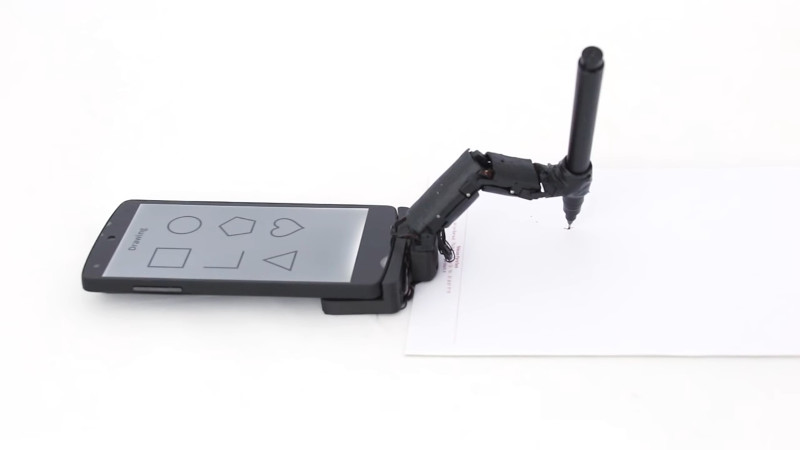The modern smartphone has a variety of ways to interact with its user – the screen, the speakers, and of course, the vibration motor. But what if your phone could interact physically? It might be unnerving, but it could also be useful – and MobiLimb explores exactly this possibility.
Yes, that’s right – it’s a finger for your mobile phone. MobiLimb has five degrees of freedom, and is built using servomotors which allow both accurate movement as well as positional feedback into the device. Additionally, a touch-sensitive potentiometer is fitted, allowing the robofinger to respond to touch inputs.
The brains behind the show are provided by an Arduino Leonardo Pro Micro, and as is usual on such projects, the mechanical assembly is 3D printed – an excellent choice for producing small, complex parts. Just imagine the difficulty of trying to produce robotic fingers with classic machine tools!
The project video shows many different possibilities for using the MobiLimb – from use as a basic notification device, to allowing the smartphone to crawl along a table. We frankly can’t wait until there’s a fully-functional scorpion chassis to drop an iPhone into – the sky really is the limit here.
Interested in other unique ways to interact with your smartphone? Check out these nifty 3D printed physical buttons.
















Hey, I will open-source everything in few days :-)
Geesh, great effort to the constructor and good post, few ways this could be augmented, interested in seeing comments on details and extension possibilities, thanks :-)
With Halloween not far away it reminds me of a B/W horror film starring a disembodied hand.
Indeed, come to think of it given the ideas offered on this post, it may be not that hard to craft a hand/wrist combo and add it to the family, let’s call it Adam – the first creation of such an autonomous disembodied hand with integral USB charging port ;-)
or the “Thing” from adams family.
It has to be turned around – so that it can touch it’s own screen.
it can LOL.
Thats a bit weird … the mind boggles with the potential uses ……
how about self playing idle-tap games?
I’ve been getting Info on this thing all ready.
I think Its been coming in as adds on Youtube.
So this is the group that invented this or did they just make a 3D Printed version of the one on the add?
It is cool.
okay let me first start with saying that (from a technical point of view) this is beautifully made, no doubt about that.
But I don’t yet get it, some applications just scared me others amazed me with their silliness. So personally I need some time to process this mentally. I wonder how the rest of the world see this project so I’ll be following the comments on this one.
Once again inexpensive phones are a way underutilized all-in-one platform for the projects that turn up on HAD. Why go Pi/Arduino/FPGA when you can get a no-contract phone for US$25 complete with camera, screen, bluetooth, wifi etc.?
and with low cost apps like Automate or Tasker thrown in…
It’s the connectivity to the outside world that’s the missing link.
It’s sooooo easy to trigger a relay (for instance) with a Pi or a microcontroller — maybe a transistor and some wire? If you need to do that with a cellphone, you’re looking at a USB stack or worse. Not a show-stopper, but it ends up adding complexity.
Teledildonics just took a giant leap forward.
Remote nose picking.
Now you CAN pick your friends nose!
“Ok Google, get my phone for me……”
One installed one of these devices.
It simply gave me the finger..
didn’t realize you beat me to the punch line.
This is amazing! This is the first real world application I’ve seen for mobile printing that’s practical. Imagine if you set it up with a 3D printing pen! Good work!
Make an entire hand with this setup.
One of the biggest problems with current prosthetics is the expense.
I did run into a variant of servos which use magnetic feedback or even optical via the well known faded sheet method.
You can actually take a piece out of one of the graduated filters from a well known photographics shop.
I was thinking of a whole hand as well.
When I really think about it though, the thumb is actually pretty special.
Not entirely sure if we can recreate the thumb by just this.
https://www.youtube.com/watch?v=M_pMlnOxotA
gives new meaning to “giving *someone* the finger”?
available at your nearest electronics store before this Christmas?